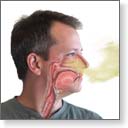| Airborne allergens |

Sneezing is not always the symptom of a cold. Sometimes, it is an allergic reaction to something in the air. According to the American Academy of Allergy, Asthma, and Immunology, 40 million Americans suffer from upper respiratory symptoms that are allergic reactions to airborne pollen. Pollen allergy, commonly called hay fever, is one of the most common chronic diseases in the United States. Worldwide, airborne dust causes the most problems for people with allergies. The respiratory symptoms of asthma, which affect more than 15 million Americans, are often provoked by airborne allergens (substances that cause an allergic reaction).
Why are some people allergic to these substances while others are not?
Scientists think that people inherit a tendency to be allergic, meaning an increased likelihood of being allergic to one or more allergens, although they probably do not have an inherited tendency to be allergic to any specific allergens. Children are much more likely to develop allergies if their parents have allergies, even if only one parent is allergic. Exposure to allergens at certain times when the body's defenses are lowered or weakened, such as after a viral infection or during pregnancy, seems to contribute to the development of allergies.
Symptoms of allergies to airborne substances
The signs and symptoms are familiar to many:
- Sneezing often accompanied by a runny or clogged nose
- Coughing and postnasal drip
- Itching eyes, nose, and throat
- Allergic shiners (dark circles under the eyes caused by increased blood flow near the sinuses)
- The "allergic salute" (in a child, persistent upward rubbing of the nose that causes a crease mark on the nose)
- Watering eyes
- Conjunctivitis (an inflammation of the membrane that lines the eyelids, causing red-rimmed, swollen eyes, and crusting of the eyelids)
In people who are not allergic, the mucus in the nasal passages simply moves foreign particles to the throat, where they are swallowed or coughed out. But something different happens to a person who is sensitive to airborne allergens.
As soon as the allergen lands on the mucous membranes lining the inside of the nose, a chain reaction occurs that leads the mast cells in these tissues to release histamine and other chemicals. These powerful chemicals contact certain cells that line some small blood vessels in the nose. This allows fluids to escape, which causes the nasal passages to swell, resulting in nasal congestion.
Created by National Institute of Allergy and Infectious Diseases
Reference
American Academy of Allergy, Asthma & Immunology (AAAAI). The Allergy Report: Science Based Findings on the Diagnosis & Treatment of Allergic Disorders, 1996-2001. Milwaukee, Wis: American Academy of Allergy, Asthma & Immunology (AAAAI); 2001. (2007 updated version available online at www.theallergyreport.com.)
Reviewed By: Allen J. Blaivas, DO, Clinical Assistant Professor of Medicine UMDNJ-NJMS, Attending Physician in the Division of Pulmonary, Critical Care, and Sleep Medicine, Department of Veteran Affairs, VA New Jersey Health Care System, East Orange, NJ. Review provided by VeriMed Healthcare Network. Previoulsy reviewed by David A. Kaufman, MD, Section Chief, Pulmonary, Critical Care & Sleep Medicine, Bridgeport Hospital-Yale New Haven Health System, and Assistant Clinical Professor, Yale University School of Medicine, New Haven, CT. Review provided by VeriMed Healthcare Network. (6/1/2010)
